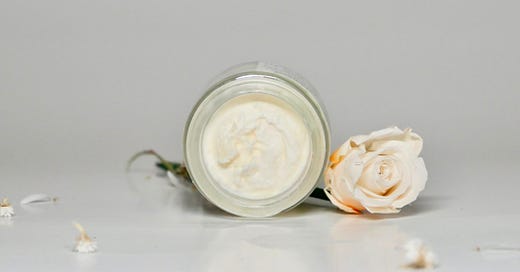Tallow vs. Olive Oil: Which One Wins for Skincare?
There are a lot of oils people put on their skin, and while olive oil might not be the first one you think of, it's definitely a staple.
So why would you use beef fat on your skin when you could just use olive oil? That would be, like, weird, right?
Well, let’s take a look! ↓
Olive Oil 🫒
Olive oil comes from—you guessed it—olives.
It’s extracted by pressing olives until the oil is released, and it can be very beneficial for the skin.
It contains vitamins and antioxidants, and I would recommend it over a moisturizer you find in the store any day. Oils, in general, do a much better job at locking in hydration than water-based products, which don’t moisturize the skin as effectively.
✅ Olive Oil Pros:
Has vitamins and antioxidants that can support skin health.
Can moisturize well and help prevent dryness.
Easy to find and relatively inexpensive.
❌ Cons:
Not very compatible with our skin. If you put it on, you’ll probably notice it just sits there for a while instead of absorbing quickly.
Can clog pores. Olive oil has a relatively high comedogenic rating, meaning it can easily cause breakouts—especially for acne-prone skin.
Final Thoughts on Olive Oil:
Olive oil is a solid option for moisturizing, and I’d definitely choose it over store-bought lotions with 20+ ingredients I can’t pronounce.
But it’s not the most skin-friendly oil out there—it’s prone to clogging pores and doesn’t absorb as well as other options.
Tallow 🐄
Now, onto tallow!
Tallow comes from beef suet, which might sound a little weird at first, but hear me out. Because it comes from an animal, it’s super compatible with our skin.
Think about it: You're a lot more similar to a cow than you are to an olive.
That alone should tell you why tallow works so much better for human skin than plant oils!
Tallow is packed with omega fatty acids, fat-soluble vitamins (A, D, E, and K), and other nutrients that our skin absolutely loves. Plus, unlike olive oil, it absorbs beautifully instead of sitting on the surface.
✅ Pros:
Highly compatible with human skin—it absorbs easily and works with our natural oils.
Full of skin-loving nutrients like vitamins A, D, E, and K.
Won’t clog pores—it has a low comedogenic rating, making it great for acne-prone skin.
❌ Cons:
Can be a little pricey compared to olive oil.
Has a mild earthy scent if left unscented (though most people don’t mind it!).
Final Thoughts on Tallow:
Tallow is one of the most skin-compatible moisturizers out there.
It nourishes, hydrates, and absorbs beautifully without clogging pores, but it’s a little harder to find and can be pricier than olive oil.
The Verdict: Tallow vs. Olive Oil
Both of these oils are great options, and I’d recommend either of them over a water-based lotion any day.
But when compared to each other, tallow is better for our skin. It’s way more compatible with our skin, won’t clog pores, and is packed with vitamins your skin loves.
So if you’ve been curious about tallow-based skincare, give it a try!
It’s especially great for acne, eczema, psoriasis, and dry skin. Check out my website to shop 100% grass-fed and finished tallow skincare.
Have a great day!
—Serena





🐄🐮🐄🐮🐄